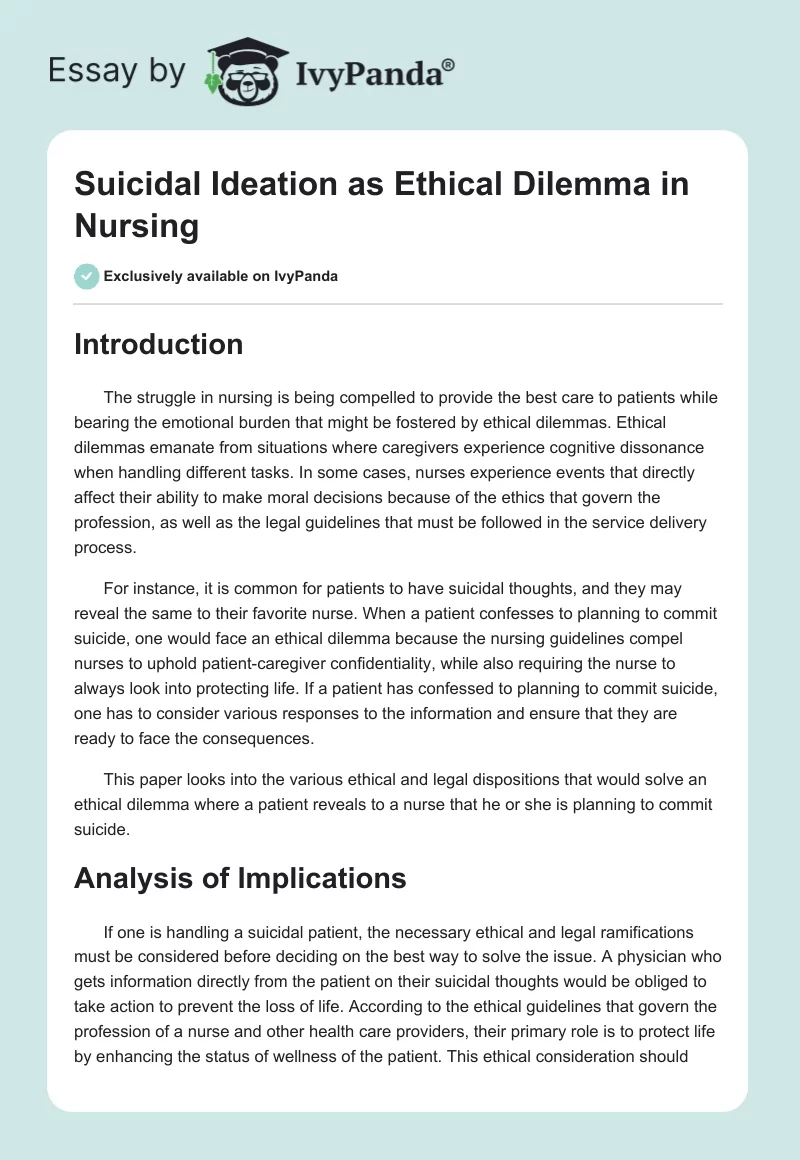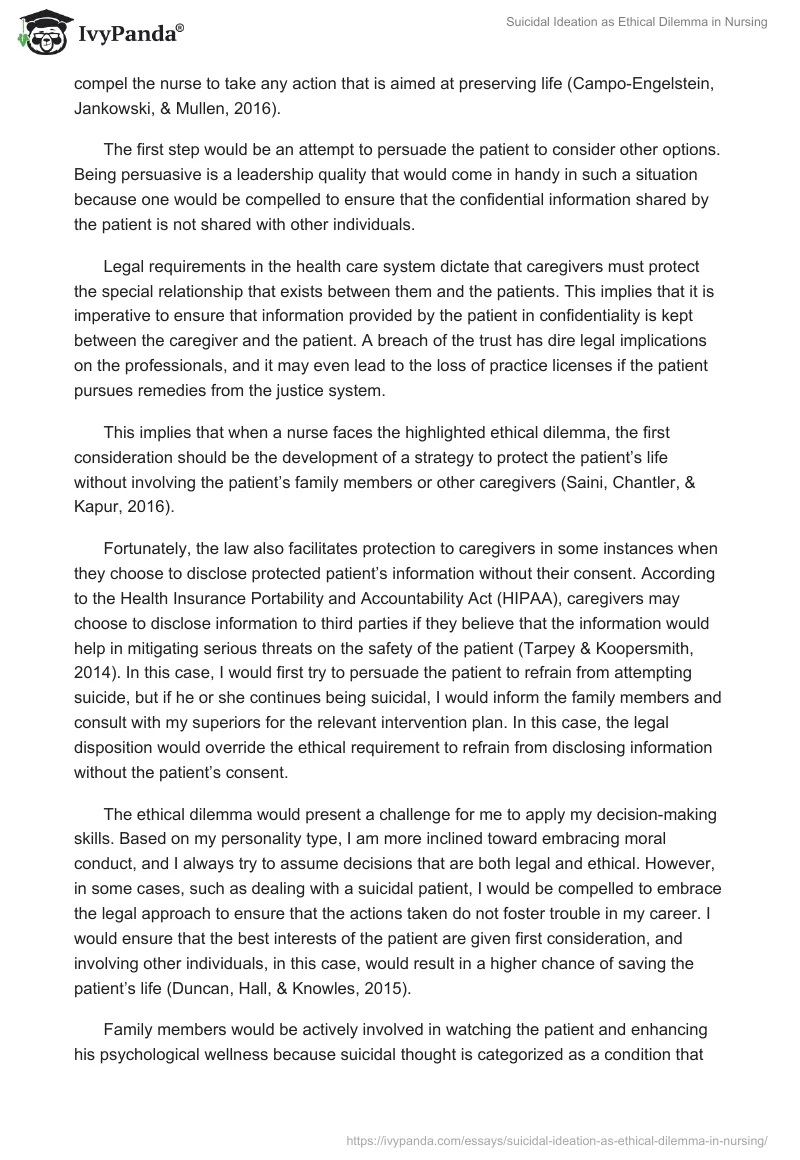Introduction
The struggle in nursing is being compelled to provide the best care to patients while bearing the emotional burden that might be fostered by ethical dilemmas. Ethical dilemmas emanate from situations where caregivers experience cognitive dissonance when handling different tasks. In some cases, nurses experience events that directly affect their ability to make moral decisions because of the ethics that govern the profession, as well as the legal guidelines that must be followed in the service delivery process.
For instance, it is common for patients to have suicidal thoughts, and they may reveal the same to their favorite nurse. When a patient confesses to planning to commit suicide, one would face an ethical dilemma because the nursing guidelines compel nurses to uphold patient-caregiver confidentiality, while also requiring the nurse to always look into protecting life. If a patient has confessed to planning to commit suicide, one has to consider various responses to the information and ensure that they are ready to face the consequences.
This paper looks into the various ethical and legal dispositions that would solve an ethical dilemma where a patient reveals to a nurse that he or she is planning to commit suicide.
Analysis of Implications
If one is handling a suicidal patient, the necessary ethical and legal ramifications must be considered before deciding on the best way to solve the issue. A physician who gets information directly from the patient on their suicidal thoughts would be obliged to take action to prevent the loss of life. According to the ethical guidelines that govern the profession of a nurse and other health care providers, their primary role is to protect life by enhancing the status of wellness of the patient. This ethical consideration should compel the nurse to take any action that is aimed at preserving life (Campo-Engelstein, Jankowski, & Mullen, 2016).
The first step would be an attempt to persuade the patient to consider other options. Being persuasive is a leadership quality that would come in handy in such a situation because one would be compelled to ensure that the confidential information shared by the patient is not shared with other individuals.
Legal requirements in the health care system dictate that caregivers must protect the special relationship that exists between them and the patients. This implies that it is imperative to ensure that information provided by the patient in confidentiality is kept between the caregiver and the patient. A breach of the trust has dire legal implications on the professionals, and it may even lead to the loss of practice licenses if the patient pursues remedies from the justice system.
This implies that when a nurse faces the highlighted ethical dilemma, the first consideration should be the development of a strategy to protect the patient’s life without involving the patient’s family members or other caregivers (Saini, Chantler, & Kapur, 2016).
Fortunately, the law also facilitates protection to caregivers in some instances when they choose to disclose protected patient’s information without their consent. According to the Health Insurance Portability and Accountability Act (HIPAA), caregivers may choose to disclose information to third parties if they believe that the information would help in mitigating serious threats on the safety of the patient (Tarpey & Koopersmith, 2014). In this case, I would first try to persuade the patient to refrain from attempting suicide, but if he or she continues being suicidal, I would inform the family members and consult with my superiors for the relevant intervention plan. In this case, the legal disposition would override the ethical requirement to refrain from disclosing information without the patient’s consent.
The ethical dilemma would present a challenge for me to apply my decision-making skills. Based on my personality type, I am more inclined toward embracing moral conduct, and I always try to assume decisions that are both legal and ethical. However, in some cases, such as dealing with a suicidal patient, I would be compelled to embrace the legal approach to ensure that the actions taken do not foster trouble in my career. I would ensure that the best interests of the patient are given first consideration, and involving other individuals, in this case, would result in a higher chance of saving the patient’s life (Duncan, Hall, & Knowles, 2015).
Family members would be actively involved in watching the patient and enhancing his psychological wellness because suicidal thought is categorized as a condition that needs psychological interventions. Involving the authorities in the health care facility would facilitate the embracement of an intervention that resonates with the organizational values, as well as the legal requirements (Jahn, Quinnett, & Ries, 2016). My role in this ethical issue would be to ensure that a moral decision is made while ensuring that the legal implications of the decision do not jeopardize my career and the values of the organization.
Leadership Style
The leadership style highlighted by the self-assessment test would be instrumental in facilitating an ethical approach toward dealing with the dilemma. The self-assessment revealed that I have the personality of a guardian, which implies that I am more likely to focus on applying the relevant procedures in every task to avoid conflicts and issues with the authorities. In this case, I would be more inclined toward focusing on the legal implications of disclosing protected patient’s information to other people.
I would ensure that the decision to disclose the information without the patient’s consent is protected by the law, and I would also ascertain that the patient is provided with 24-hour surveillance while in the hospital and at home to eliminate chances to commit suicide (Pirschel, 2016). As a leader with a guardian personality, I would also be inclined toward helping the family members to convince the patient to stop considering suicide as an option to eliminate his or her pain and worries.
Conclusion
Ethical dilemmas in the health care system can be quite challenging for nurses, especially when the dilemma entails protected patient’s information. The ethical guidelines governing the profession require caregivers to actively keep confidential information shared by the patient’s secret, and a breach of this requirement might result in dire legal consequences. However, when faced with a suicidal patient who adamantly seeks to end their life, one would have to apply the HIPAA provisions for disclosure of patient information.
I would not hesitate to disclose such information because it is apparent that failing to do so would imply that I support the patient’s decision to end his or her life. Additionally, disclosure would be based on the premise that governs nurses’ conduct, with reference to the protection of life.
References
Campo-Engelstein, L., Jankowski, J., & Mullen, M. (2016). Should health care providers uphold the DNR of a terminally Ill patient who attempts suicide? HEC Forum, 28(2), 169-174.
Duncan, R. E., Hall, A. C., & Knowles, A. (2015). Ethical dilemmas of confidentiality with adolescent clients: case studies from psychologists. Ethics & Behavior, 25(3), 197-221.
Jahn, D. R., Quinnett, P., & Ries, R. (2016). The influence of training and experience on mental health practitioners’ comfort working with suicidal individuals. Professional Psychology: Research & Practice, 47(2), 130-138.
Pirschel, C. (2016). Ethical dilemmas at the end of life. ONS Connect, 31(9), 10-14.
Saini, P., Chantler, K., & Kapur, N. (2016). General practitioners’ perspectives on primary care consultations for suicidal patients. Health & Social Care in the Community, 24(3), 260-269.
Tarpey, C.M. & Koopersmith, E.G. (2014). Understanding physicians’ duties toward suicidal patients. Web.


